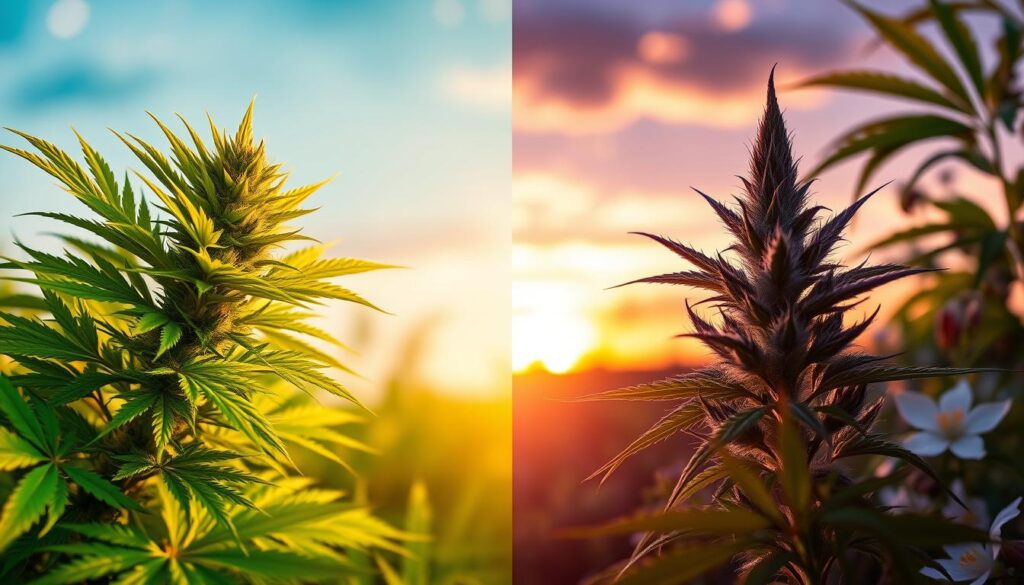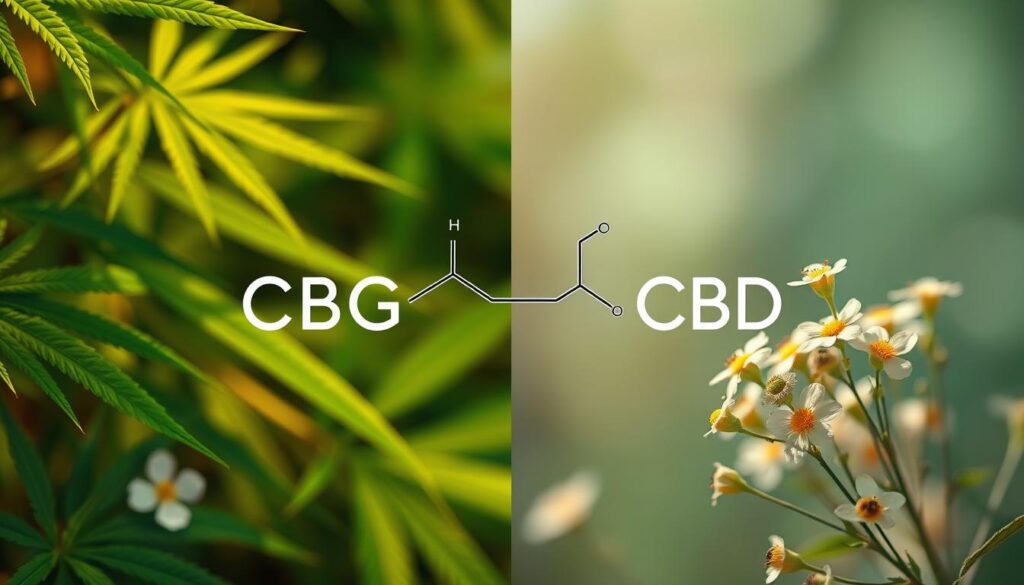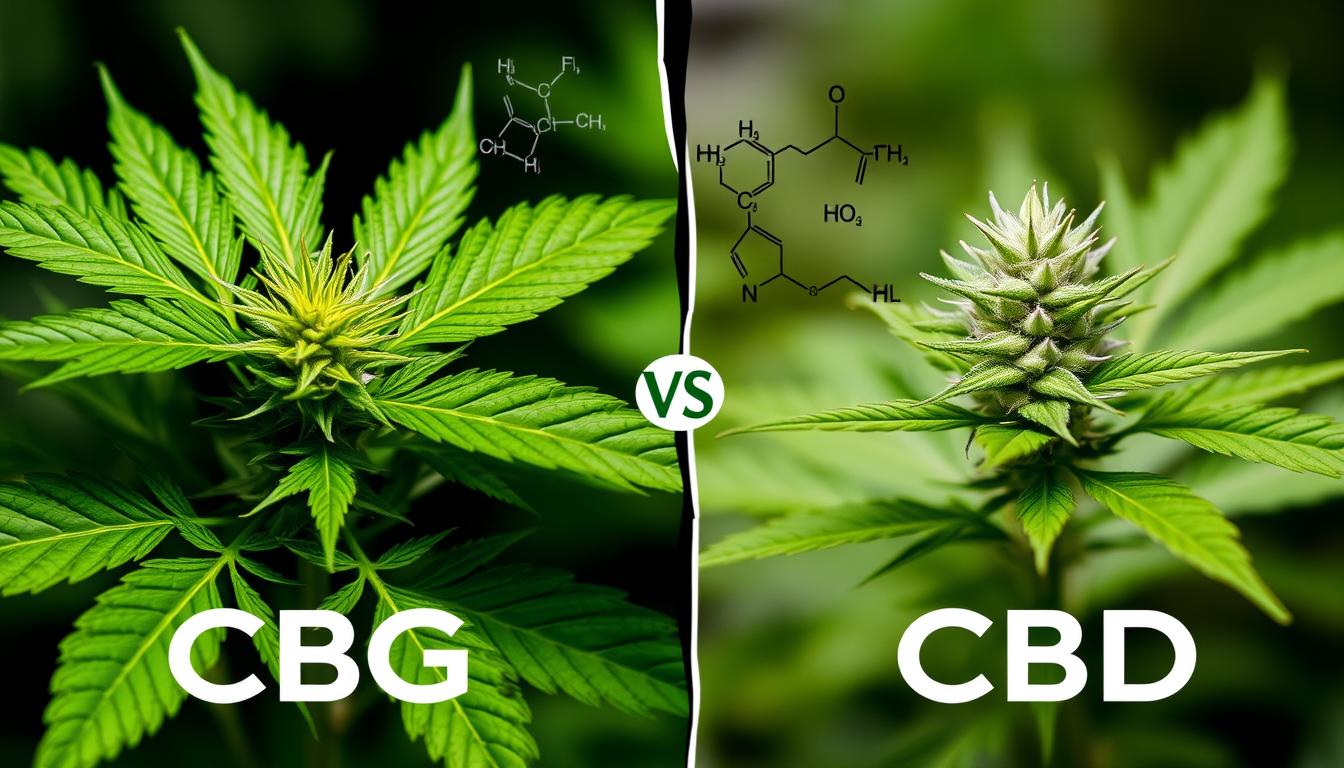When we talk about cannabinoids, CBG and CBD are always in the spotlight. Both come from the cannabis plant, which has over 113 cannabinoids. Each one has its own benefits and properties. CBD is well-known and studied a lot, found in many products. On the other hand, CBG is less common because it’s found in smaller amounts.
This article will look into the differences between CBG and CBD. We’ll see how they have different uses in wellness products. The good news is that neither CBG nor CBD gets you high. This makes them great for natural relief without any psychoactive effects.
Key Takeaways
- CBG is considered a minor cannabinoid, while CBD is the most prominent and studied cannabinoid in hemp.
- Both compounds are non-psychoactive and do not induce a “high.”
- Understanding cannabinoid differences helps consumers select the right product for their health needs.
- CBG may have unique therapeutic applications that set it apart from CBD, such as potential antibacterial effects.
- The comparison of CBG and CBD is essential for grasping their individual benefits in wellness routines.
Understanding Cannabinoids
Cannabinoids are a group of chemicals that interact with our body’s endocannabinoid system. This system is key to keeping our body in balance. The hemp plant (Cannabis Sativa L) is home to over a hundred cannabinoids. CBG (cannabigerol) is one of these, found in small amounts in mature plants.
CBG is called “The Mother of All Cannabinoids.” It’s a starting point for making other cannabinoids like CBD and THC. In 1975, scientists in Israel found CBGA, CBG’s acidic form. In 1996, Japanese researchers found that CBGA is a key building block for many cannabinoids.
Research on cannabis compounds is still growing. Studies show that acidic cannabinoids, like CBGA and CBDA, might have similar benefits to their active forms. A study found that CBGA and CBDA could stop the SARS-CoV-2 virus from entering cells. This is a promising area for more research.
The way cannabinoids bind to receptors is important for their effects. CBG has a strong bond with CB2 receptors, unlike CBD which binds to both CB1 and CB2. Both cannabinoids show promise in treating inflammation and supporting brain health. As research goes on, cannabinoids like CBG and CBD could lead to new health benefits.
What is CBG?
CBG, or cannabigerol, is known as the “mother of all cannabinoids.” It turns into CBD and THC. It’s found in small amounts (1-2%) in many cannabis strains. People are starting to see its health benefits.
CBG is special because it doesn’t make you high. This makes it great for those who want cannabis benefits without the psychoactive effects. Research shows it could help with inflammatory bowel disease and neurodegenerative disorders. It might even reduce inflammation.
CBG is unique among cannabinoids. It’s found in younger hemp plants. This gives it a different set of benefits. I’m excited to learn more about its role in health and how it compares to CBD.
What is CBD?
CBD, or cannabidiol, is a well-studied compound from the hemp plant, Cannabis Sativa L. It makes up about 40% of hemp extract and has many health benefits. Knowing about CBD helps us see why it’s popular in health and wellness.
CBD is special because it doesn’t make you high like THC does. You can find it in oils, tinctures, capsules, and edibles. Studies suggest it might help with anxiety, pain, and seizures.
CBD works with our body’s endocannabinoid system, mainly with CB2 receptors. This interaction could help with health issues without making you feel high. The government also recognizes CBD’s medical value, especially for epilepsy treatment.
More studies are coming out on CBD’s benefits for our well-being. Learning about CBD can help people decide if it’s right for them.
CBG vs CBD: Key Differences
The comparison of cbg and cbd shows key differences. CBG is a precursor to CBD and THC. It’s found in small amounts in mature plants, unlike CBD which is more common.
CBG comes from younger hemp plants, while CBD is from older ones. This affects their benefits. CBG might help with inflammation, while CBD is known for treating anxiety and seizures.
Both help the endocannabinoid system, but in different ways. CBG might help with inflammation, and CBD is good for seizures. Research is growing on CBG’s effects on the brain.

| Attribute | CBG | CBD |
|---|---|---|
| Type | Minor Cannabinoid | Major Cannabinoid |
| Concentration in Plants | Less than 0.1% | Higher levels, varies by strain |
| Source for Extraction | Younger Plants | Mature Plants |
| Receptor Affinity | Strong for CB2 | Equal affinity for CB1 and CB2 |
| Primary Benefits | Potential inflammation reduction, neuroprotective properties | Anti-inflammatory effects, seizure control, anxiety relief |
In summary, CBG and CBD have unique roles in understanding cannabinoids. As research grows, knowing their differences helps tailor treatments and wellness.
Benefits of CBG
CBG is gaining attention for its health benefits. It has unique properties that can improve overall well-being. As a cannabinoid, CBG offers several therapeutic advantages that are becoming more recognized in the wellness community.
Antimicrobial and Antifungal Properties
Research shows that CBG has strong antimicrobial and antifungal properties. This makes it a promising option for treating infections. It offers a natural alternative to traditional treatments.
Inflammation Reduction
CBG has significant anti-inflammatory effects. Studies suggest it can help manage chronic inflammatory conditions. This includes conditions like arthritis or inflammatory bowel disease. CBG could provide relief for those seeking new treatment options.
Antioxidant Effects
CBG’s antioxidative properties are crucial in fighting oxidative stress and related health issues. It neutralizes free radicals, helping maintain cellular integrity and promoting longevity. This highlights its potential as a beneficial component in wellness regimens.
Benefits of CBD
CBD offers many benefits backed by research. It helps with pain, anxiety, and controlling seizures. This makes it a great choice for improving overall health.
Pain Relief
CBD has strong anti-inflammatory and pain-relieving effects. It’s great for those with chronic pain. Studies show it can reduce inflammation and pain well.
A 2021 review found CBD works well in many studies. It’s a good choice for managing pain.
Anxiety and Stress Relief
CBD also helps with anxiety and stress. A 2020 study looked at several studies and found positive results. It helps people with anxiety disorders feel better.
Many people say CBD helps them manage anxiety. This improves their daily life and overall well-being.
Seizure Control
CBD is known for helping control seizures, especially in kids with certain syndromes. The FDA approved it in 2018. This shows its value as a treatment.
Systematic reviews have shown CBD can lower seizure rates. This highlights its potential as a treatment option.
CBG vs CBD: Extraction Methods
Learning about CBG and CBD extraction is key for those diving into cannabinoids. The way cannabinoids are extracted affects their purity and how well they work. There are over a hundred cannabinoids in the hemp plant, Cannabis Sativa L. CBG is a minor cannabinoid because it’s less common in mature plants than CBD.
CBG comes from younger hemp plants, where it’s more abundant. Scientists in Israel first found CBGA, the acidic form of CBG, in 1975. Later, research showed CBGA is the base for all cannabinoids, including CBD and THC. This makes it crucial for making cannabinoids.
There are many ways to extract cannabinoids, each affecting the quality of the final product. Some common methods include:
- CO2 Extraction: This method is known for making high-quality extracts without harmful solvents.
- Ethanol Extraction: It uses high-proof alcohol to get cannabinoids, offering a clean and effective way.
- Full-Spectrum Extraction: This method keeps all cannabinoids and terpenes, aiming for the best entourage effect.
For CBD, producers often use older plants with more CBD. This means different extraction methods can change the final product’s quality. Knowing about CBG and CBD extraction is important for getting the best products.
Similarities Between CBG and CBD
Exploring CBG and CBD, I find it interesting how they share many traits. Both are non-psychoactive, meaning they don’t cause a ‘high’ like THC. This makes them great for those looking for health benefits without the mind-altering effects.
CBG and CBD both work with the endocannabinoid system. This system is key to our body’s functions. They might offer similar health benefits, like reducing inflammation, as studies have shown.
When used together, CBG and CBD show a special synergy. This mix could boost their health benefits, offering more wellness advantages. Many are now trying this combination in products they buy.
The table below outlines key similarities between CBG and CBD:
| Characteristic | CBG | CBD |
|---|---|---|
| Non-Psychoactive | Yes | Yes |
| Interaction with Endocannabinoid System | Yes | Yes |
| Potential Anti-Inflammatory Effects | Yes | Yes |
| Research Status | Emerging | Well-Established |
| Market Availability | Increasing | Growing Significantly |

How CBG Differs from CBD in Interaction with Receptors
Cannabinoids interact with the body’s receptors in complex ways. This is key to understanding their effects. CBG has a stronger bond with CB2 receptors, which are linked to the immune system. This can lead to unique benefits, especially in fighting inflammation.
CBD, on the other hand, interacts with both CB1 and CB2 receptors but less strongly. Since CB1 receptors are in the brain, CBD might affect mood and anxiety more broadly than CBG. This difference in receptor interaction is crucial in understanding their effects and benefits.
As more people learn about these cannabinoids, knowing how they interact with receptors is vital. It opens doors for new research and products. It’s interesting to see how their different affinities lead to different uses in medicine.
| Cannabinoid | Primary Receptor Affinity | Potential Effects |
|---|---|---|
| CBG | High for CB2 | Immune modulation, anti-inflammatory |
| CBD | Moderate for CB1 and CB2 | Mood stabilization, anxiety relief |
CBG and CBD Products Available on the Market
The wellness market is buzzing with CBG and CBD products. Over 100 cannabinoids exist in hemp, making CBD very popular. Now, you can find CBG and CBD in many forms, fitting different tastes.
Choosing the right product can be tough, but knowing your options helps. Here are some common types:
- Oils and Tinctures
- Capsules and Gummies
- Topical Creams
- Vaporizable Products
Quality is key when picking CBG and CBD products. Look for products with clear labels and lab test results. This ensures you get safe and effective products. Researching brands is also important.
The entourage effect is another thing to consider. Using CBD and CBG together can offer better benefits. CBD helps with sleep, while CBG boosts energy and focus. This mix can improve your overall well-being.
| Product Type | Onset Time | Benefits |
|---|---|---|
| Oils and Tinctures | 10-15 minutes | Quick absorption and versatile use |
| Gummies and Capsules | 45-60 minutes | Consistent dosing |
| Topicals | Varies | Targeted physical support without mental effects |
| Smokable/Vape Products | 5-10 minutes | Rapid absorption for quick effects |
Exploring CBG and CBD products can greatly improve your well-being. By choosing wisely, you can enjoy their benefits.
CBG and CBD Research: Current Findings
Research on CBG and CBD is growing fast. We’re learning more about these compounds and how they can help us. Cannabis sativa has over 400 chemicals, with about 80 that affect our bodies.
CBD is getting a lot of attention. Health experts say it’s good for many medical issues. The FDA has approved CBD oil for treating certain seizure disorders.
Studies show CBD can reduce inflammation. It does this by stopping the release of compounds that cause inflammation. CBG, on the other hand, is being studied for its potential in treating diseases like Huntington’s and colitis.
More research is needed on CBG and CBD. CBG might fight off infections, while CBD can help with pain, anxiety, and seizures. As we learn more, we’ll find new ways to use these compounds to help people.
Conclusion
Reflecting on CBG and CBD, it’s clear they’re both crucial for our health. CBG is like a ‘stem cell’ for cannabinoids, while CBD is known for its wide use and health benefits. Both have unique qualities that can improve our well-being.
Learning about their differences, I see that CBG is more abundant in young plants. This makes it more expensive to produce. Yet, combining CBG and CBD can lead to better health outcomes. People say CBG helps with sleep and mood.
Both CBG and CBD are safe, offering health benefits without the risks of regular medicines. As studies grow, we’ll see more ways they can help us. Knowing how they work helps me choose the best options for my health.

Leave a Reply
You must be logged in to post a comment.